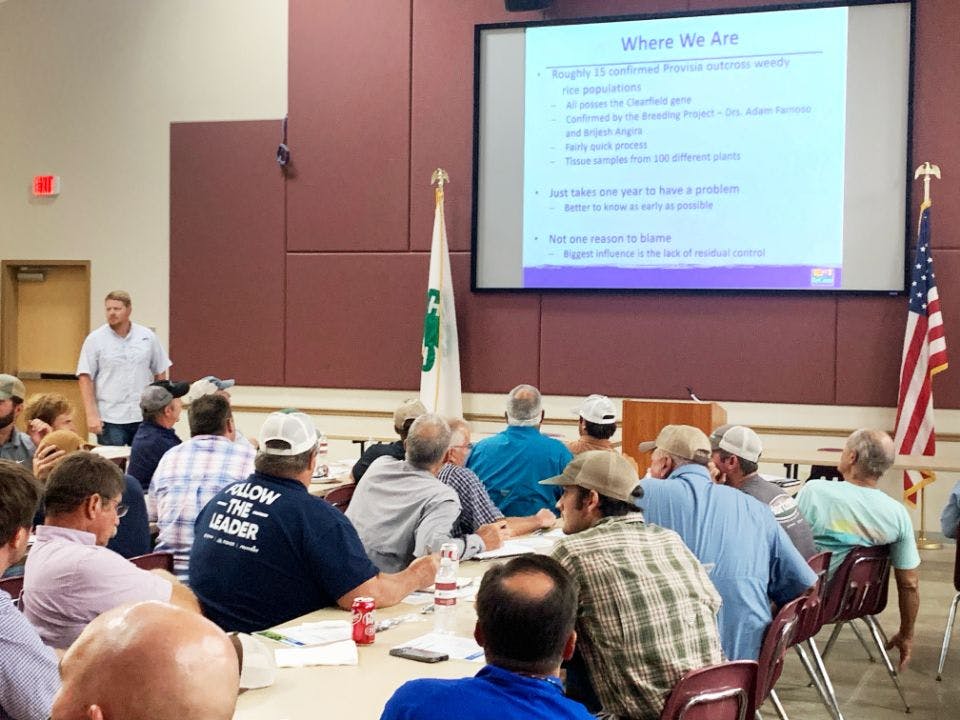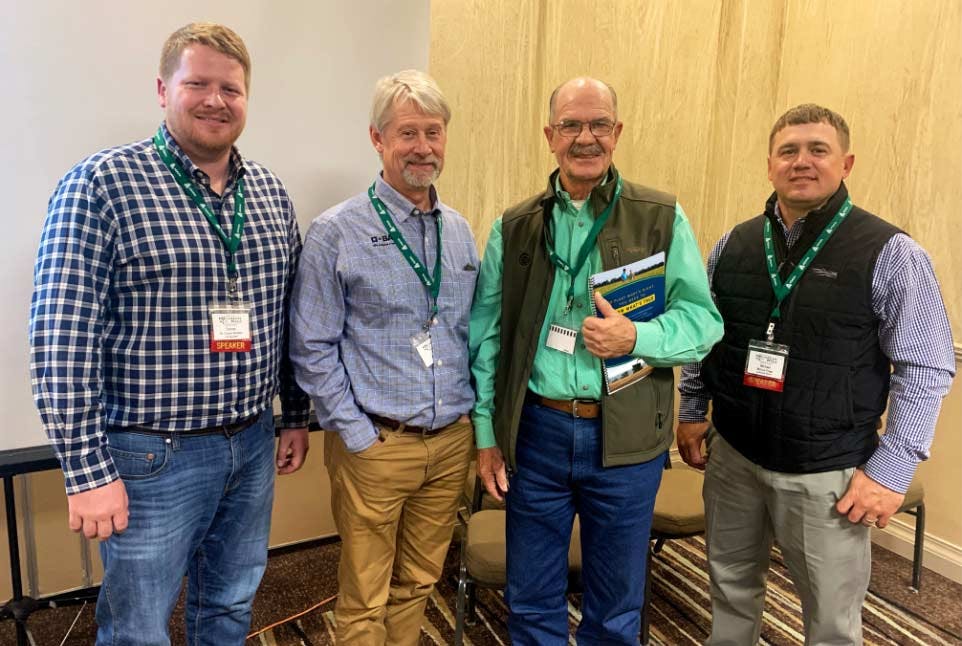HORIZON AG E-NEWS
Best Management Practices for Provisia Rice
The Provisia® Rice System with Horizon Ag PVL03 is expected to go out on significantly more acres in 2023 throughout the southern rice production region, based on comments and farmer engagement at the recent 26th annual National Conservation Systems Cotton & Rice Conference in Baton Rouge.
That means it is more important than ever to learn from early mistakes made with the system that contributed to instances of weedy rice outcrosses and to implement recommended Best Management Practices (BMPs) to better steward the technology.
The Provisia® Rice System with Horizon Ag PVL03 is expected to go out on significantly more acres in 2023 throughout the southern rice production region, based on comments and farmer engagement at the recent 26th annual National Conservation Systems Cotton & Rice Conference in Baton Rouge.
That means it is more important than ever to learn from early mistakes made with the system that contributed to instances of weedy rice outcrosses and to implement recommended Best Management Practices (BMPs) to better steward the technology.
Dr. Ronnie Levy, LSU AgCenter Rice Specialist, told conference attendees that PVL03 acres will likely double in Louisiana alone this season after the strong performance of the variety and Provisia technology in 2022, producing good yields and quality while enabling many farmers to begin to control weedy rice.
At the same time, after about 15 instances of outcrosses to the ACCase inhibitor herbicide system were confirmed in 2022, the threat of resistance is a serious concern, spurring industry leaders, consultants and farmers to gather around a common cause — using proven management practices to help keep the technology viable for as many seasons as possible.

Dr. Tim Walker, Horizon Ag general manager, led discussions with farmers and consultants from South Louisiana and the North Delta sharing their experiences with Provisia and PVL03.
The Provisia Working Group, made up of representatives from Horizon Ag, BASF, rice industry dealers and distributors, and Louisiana State University AgCenter research and extension faculty, met last fall to refine BMPs for the system. Since then, its recommendations have been broadly communicated to farmers and consultants in agricultural meetings across the region. Those BMPs were the topic of two packed panel sessions during the recent Conservation Systems conference, with participants sharing early experiences with Provisia and recommendations moving forward.
“When we were first alerted to the issue and confirmed the outcrosses, our approach was to hit it head on, not stick our heads in the sand,” said Dr. Tim Walker, Horizon Ag general manager. “This is a great technology. It is, right now, the only technology we have to combat the weedy rice problem that is a huge issue in many areas. That’s why such a broad spectrum of industry and university representatives, even competitors, came together quickly to address the issue. The goal is to minimize the development of outcrossing so we can prolong the effectiveness of the Provisia Rice System as long as we can.”
Dr. Connor Webster, LSU AgCenter weed scientist and one of the panelists at the conference, said the development of outcrosses to the technology in some fields after only five seasons of availability wasn’t necessarily a surprise, based on some of the initial application practices.

Panel participants included Dr. Connor Webster, LSU Agcenter; Dr. Brad Guice, BASF; BD Fontenot, Nutrien Ag Solutions; and Michael Fruge, Louisiana rice farmer.
“The biggest issue is people using Provisia as a silver bullet for grass control and kicking residuals out of their program,” said Dr. Webster. “We need to still be using residual herbicides. Provisia is very effective, but farmers should be using Provisia herbicide to control weedy rice or red rice and using residuals to get ahead of other grass and broadleaf weeds.”
That thought was echoed by BD Fontenot, a crop consultant with Nutrien Ag Solutions in Elton, Louisiana. “Some of the problems we had in South Louisiana last year were brought on when we could not get coverage because there were too many weeds in the field,” said Fontenot. “Farmers assumed that Provisia herbicide was a magic grass product that would take care of everything. The better way to approach it is to treat it like we would any other rice. Start with a clean seed bed. Spray when weeds are small and actively growing, and then overlap with residual herbicides. That way, you are able to target the undesirable rice with Provisia. If other weed complexes are in the field, you are not going to get coverage, and you are going to have escapes.”
Dr. Webster noted that farmers should let the size and population of weedy rice dictate follow- up applications. Rather than relying on a strict calendar day schedule between sprays, there needs to be a sufficient amount of weedy rice or red rice present when making the second and third Provisia applications. Knowing the history of the infestation in a particular field is beneficial when making decisions about follow-up applications.
He also recommended using higher carrier volumes of 10-15 GPA by ground and by air to ensure good Provisia contact and coverage and only tank mixing when weedy rice and grasses are small.
Provisia Rice System BMPs
- Use recommended residual herbicides.
Command®, Prowl® and Facet® herbicides with grass activity control grass so that maximum coverage can occur with Provisia herbicide onto the weedy rice. Using residual herbicides for broadleaf activity PRE or DPRE (Sharpen®, Prowl, Facet, or Gambit® herbicides) will also reduce the need to tank mix with the Provisia herbicide. - Be cautious of tank mixing herbicides that might lead to antagonism with your Provisia application.
Make at least one application of Provisia herbicide alone or two applications alone in a three-pass system. The size and population of weedy rice should always dictate follow-up applications. - Know which herbicides to mix and which not to mix.
ALS-inhibiting herbicides can antagonize Provisia herbicide, although a second Provisia herbicide application 28 days after initial treatment can overcome much of the antagonism. Grasp® and Regiment® herbicides should be avoided for a tank mix, while sulfonylurea herbicides are better choices. For contact herbicides, Stam® herbicide severely antagonized Provisia herbicide activity, so propanil mixtures should be avoided. Basagran® and Sharpen herbicides antagonized Provisia herbicide activity at 14 days after treatment but were not antagonistic at 28 days. - Be diligent and clean fields up late-season.
If weedy rice is present, it needs to be taken out. This may mean using late-season herbicide applications, roguing or spot spraying. - Consider crop rotation for success with Provisia rice.
Do not plant in the year following Clearfield® rice or where an imidazolinone herbicide was used the previous year due to the risk of carryover damage from the herbicide. Do not plant Provisia rice after Provisia rice in the same field. - Be aggressive in fallow ground and soybeans.
Use tillage and Roundup® herbicide with residuals to increase the time between applications.
Provisia Herbicide Recommendations
- BASF has developed a Technical Bulletin with specific recommendations for managing Provisia herbicide. These include:
- Use only Provisia herbicide over the top of Provisia rice.
- Start clean, with burndown and/or tillage.
- Let the size and population of weedy rice dictate follow-up applications.
- Use residuals like grass and broadleaf herbicides for broad-spectrum control.
- Do not mix Provisia herbicide with herbicides that have the potential to be antagonistic.
- Apply to actively growing grasses, red rice and volunteer rice.
- Make at least two (but no more than three) Provisia herbicide applications no later than panicle initiation.
- Use proper carrier volumes of 10–15 GPA by ground and by air.
- Clean equipment/combines.
- Harvest fields with weedy rice last.
Stewardship In Crawfish Production
- Don’t allow Provisia rice to go to seed in crawfish production.
- Don’t allow Provisia rice to go to seed in a non-rice year, including fallow or crawfish fields.
- Control weedy rice and red rice at pond edges with glyphosate or other chemical or cultural methods.
- Avoid using Provisia rice for green rice/crawfish forage production.
